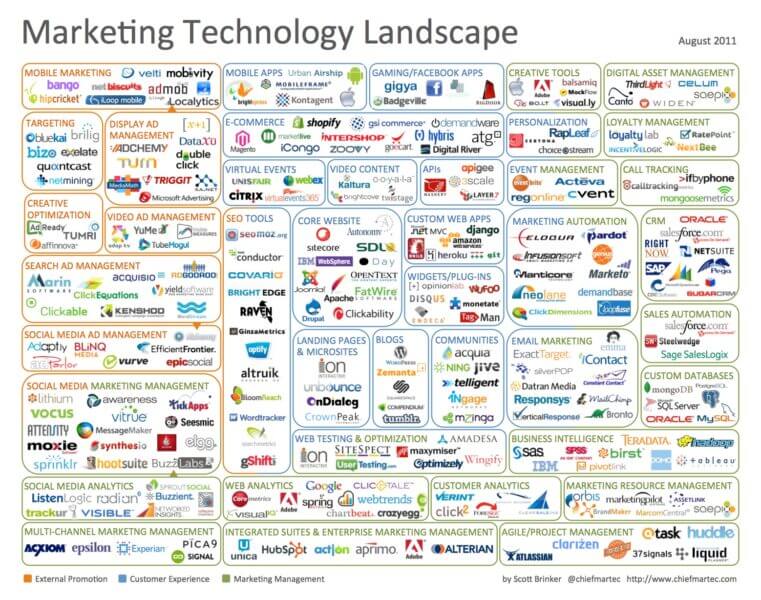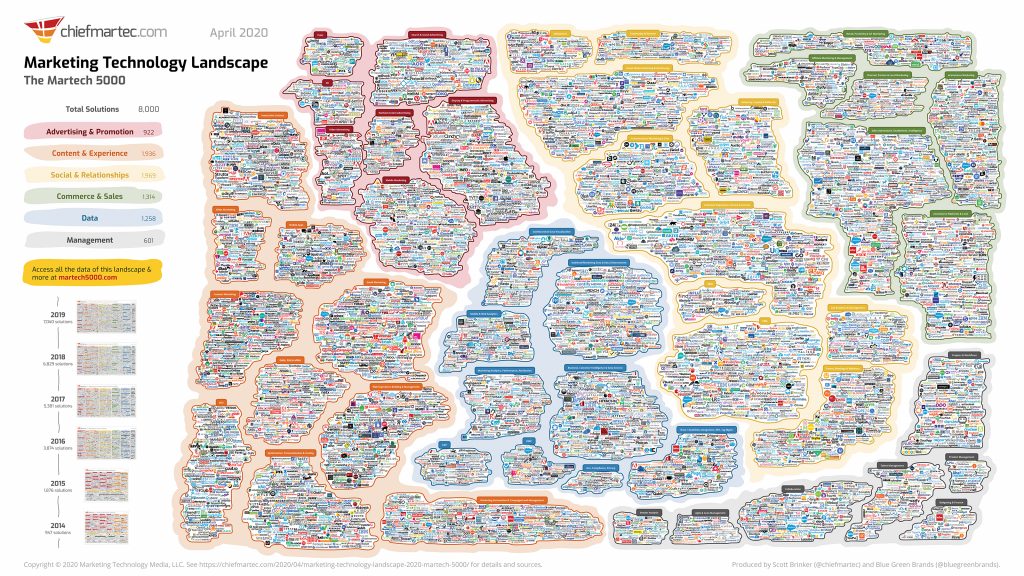Walk through a step-by-step process to identify the technology vendors that best fit your company’s needs.
Choosing a technology partner used to be easy. I can remember looking at Scott Brinker’s first map of the marketing technology landscape in 2011 and thinking, “Okay, there are a few choices. This should be easy.”
Here’s what that first Marketing Technology Landscape looked like:

Back then, email was limited in what it could do. So, tech partners were few and far between.
Here’s what the Marketing Technology Landscape looks like today, just eleven years later:

More categories. A total of 8,000 providers. Boom!
The impact on email
This massive market evolution has been both good and confusing for our industry. We’ve seen the growth of companies like Phrasee and Liveclicker, Movable Ink, SmarterHQ, FreshRelevance and Kickbox and a hundred other companies that help marketers do their jobs more efficiently and effectively. We’ve also seen a ton of mergers and acquisitions over the past few years, combining individual SaaS products into comprehensive platforms.
Seeing all these companies come into their own over the last eleven years signifies two different things:
- The space is more vibrant than ever. Notice how nobody has claimed email is dead lately?
- With so many choices, finding the right tech partners has become overwhelming. Not only in the execution of our programs but realizing what we must do to get campaigns out the door and to get our customers’ attention and conversions.
Looking at the latest martech landscape turns my mind to mush, especially when I think about choices facing executives of digital marketing programs. And not just in the email category, but in search and social marketing, too.
You must keep your digital marketing program profitable, increase KPIs year after year and find that secret sauce to add to your program that’s new and innovative.
5 steps to navigate the increasingly complex martech landscape
This chart shows that you can buy it better than you can build it today. But how do you go about not just choosing the right email service program but also the right list-cleaning vendor, the right source of help for GDPR compliance, deliverability reporting or real-time images and copy in email?
Having been both the vendor and buyer of marketing technology, I’ve come up with five steps to clarify the choices you must make.
1. Stick to what you need, not what’s cool.
John Caldwell, the founder of what became RPE Origin Agency, preaches the need to look at your functional requirements when evaluating vendors. He asks, “What are your ‘nice to have’ features, and what are your ‘need to have’ features?”
Many of us go into vendor selection looking for “cool to do” things. “Cool to do” is not a requirement. It’s something for the wish list unless it helps you achieve the outcomes you want.
Before you call a vendor, look at a martech landscape like the ones I shared above or check the latest Gartner or Forrester reports and understand what you need and what your desired outcomes should be.
That could be integration across your entire organization or integrating email with your CRM or POS systems or meeting executive-level expectations.
You don’t have to rush into publishing an RFP right away (Hint: everybody hates RFPs) or even write everything down in that style. But thinking in this needs- and outcome-focused way does help you avoid being distracted by the “ain’t it cool” features.
2. Get stakeholder buy-in first.
Once you’ve developed your list of needs, vet it across your organization. It’s best to do this at the beginning of your search, rather than waiting until the middle, when things explode and someone gives you a requirement you weren’t expecting.
Having everyone’s buy-in early in the process gives you the information you need and focuses the organization’s attention on what you’re trying to achieve.
3. Ask around.
The contemporary Marketing Technology Landscape shows you have maybe 100 different companies to choose from for everything you want to do. There’s no way you can go to a resource like that and gain any knowledge about who the right vendors would be for what you need.
The chart demonstrates density, but it lacks clarity in your choices.
So, you still have work to do, but you’re not alone. There are enough resources and knowledge in the industry to help you make the right decision.
The first place to start is your ESP. This should be your first call because it’s likely they’ve talked to many of the companies in the section of the martech market you’re researching. They should know who’s legitimate, who they or other clients use now and which companies will integrate with your platform.
Also, check with industry insiders who know the landscape or have worked with vendors you’re interested in. Use marketer forums like Only Influencers or consulting groups such as Gartner, Forrester, David Daniels’ The Relevancy Group, Trendline Interactive and RPE Origin Agency.
Once you gather your intelligence, write it down in a report. That way, when your fellow stakeholders ask why you picked a certain vendor, you can show them what recommendations you got, who gave them to you and what resources you used to reach your decision.
4. Evaluate your recommendations.
A lot of people get excited about the possibilities that a new vendor can give them. I’ve seen over and over how excitement about “ain’t it cool” features can cloud companies’ judgments about their recommendations.
Be sure you stick to what you need to have and remember the feedback you got from your stakeholders and industry advisers. Confront any red flags and potential challenges you find in your evaluations.
5. Keep an eye on the cost.
Make sure the financial model you’re planning with your new technology doesn’t make email unprofitable.
This means you aren’t always going to launch a campaign using your new enhancement technology to all the people on your mailing list.
For example, video in email can be a cool feature. It can even be the feature that you identified as a “need to have.” But, it doesn’t work for everybody across all email clients. You wouldn’t send video-in-email messages to domains that don’t play that technology. If you did, you’d waste money and impressions.
You always want to look at the best audience for the technology you want to use and what the price would be. Don’t assume the cost will be based on full execution to your entire list unless that’s what you need to do to achieve the outcomes you identified previously.
Along with your cost evaluations, make sure you incorporate a testing scenario to measure your success. As I mentioned before, you need to know the outcomes you want and the KPIs you will use to measure it.
Wrapping up
All this information can be tedious to gather, but it will help you navigate the complex and confusing landscape of marketing technology. Charts like the ones I shared above will not help you pick a vendor, but they demonstrate the density of this space and get everyone excited about the amount of technology and innovation that complements our efforts.


Recent Comments